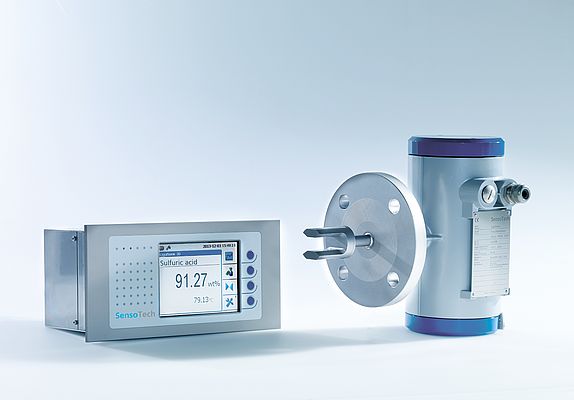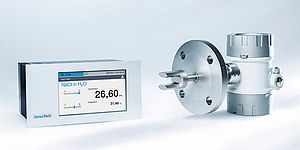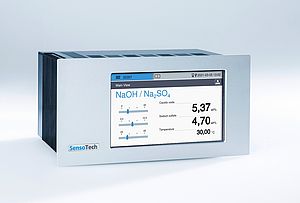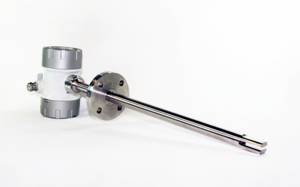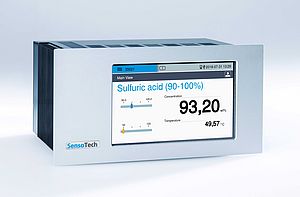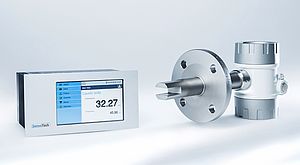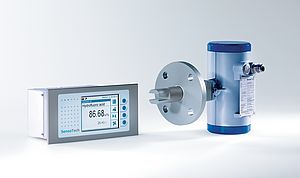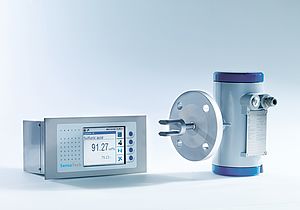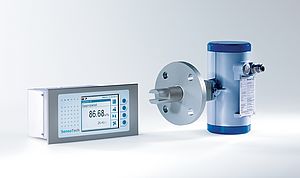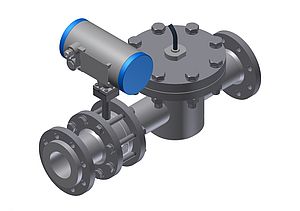The production of sulfuric acid is an important process, because sulfuric acid is one of the chemicals most commonly used. Two main methods for the production of sulfuric acid are the double contact process and the WSA process. Both processes occur, for example, in the chemical, petrochemical and mining sector. The produced sulfuric acid is used as raw material or catalyst for the production of diverse products including processes like alkylation, syngas drying, fertilizer production, etching and pickling baths or mine-ore processing.
Monitoring the sulfuric acid strength (wt%) online and in real time enhances safety and efficiency of the plants. Manual sampling is time-consuming and may involve security risks. The laboratory analyses provide only delayed data making a timely intervention in the process impossible. With inline measuring methods, the sulfuric acid strength can be monitored directly in the process and in real time. Such methods enable a continuous measurement providing the data online.
Due to the physical properties of sulfuric acid, the most suitable measuring method for determining the acid strength is sonic velocity measurement. Figure 1 shows the dependence of sonic velocity, conductivity and density on the acid concentration (wt%). Conductivity probes do not provide a clear signal between 80 wt% and 95 wt%. Also density meters are not suitable, as density does not provide a clear signal between 95 wt% and 100 wt%. The LiquiSonic® analyzers (figure 2) by the company SensoTech are based on sonic velocity measurement overcoming the dual sensitivities of both conductivity and density. In production processes of the chemical, petrochemical and mining industry, the relevant concentrations range from 70 wt% to 100 wt% sulfuric acid, 20 wt% to 35 wt% oleum or 50 wt% to 60 wt% oleum. Here, the sonic velocity meters provide clear and high-precision data of the acid strength.
In pickling and etching baths of the metal and chemical sector, the concentrations usually range between 0 wt% and 30 wt%. Also in such processes, the LiquiSonic® sensors reliably measure the acid strength. In the bath, sonic velocity is combined with a second physical value to determine the salt concentration as well.
If the measuring values exceed or fall below critical process thresholds, a signal will be sent immediately ensuring timely countermeasures can be initiated. The real-time information significantly increases work environment safety and product quality and reduces costs caused by acid wastage and failed production. Both a too high and a too low concentrated acid is reliably detected. Signaling a too low acid strength, sonic velocity meters are also used to recognize acid runaways. This avoids security risks, damages from corrosion and costs resulting from lost production. Furthermore, an online monitoring reduces the consumption of sulfuric acid to optimize the process efficiency. For example, in alkylation units in refineries, sonic velocity meters enable a lowering of the spent acid and an efficient control of the rate of fresh acid addition.
The LiquiSonic® analyzers are successfully used to determine the sulfuric acid strength in plants worldwide. The sensors are installed directly into existing pipes or vessels. Due to modern and high-end technology the sensors provide stable measuring results updated every second with an accuracy of up to 0.03 wt%. For process automation, the real-time data can be transferred to process control systems via 4-20 mA signal, digital outputs, fieldbus or Ethernet.
Made of Hastelloy C-2000, the sensors are absolutely resistant to corrosion. The robust construction requires neither gaskets nor moving parts, so the sensors are maintenance-free with long-term stability. The LiquiSonic® measuring method is based on a travel time measurement, sending a sonic signal from one to the other side of the sensor (figure 3). Because the distance between transmitter and receiver is known and constant, the sonic velocity can be determined using the data of path and time. The acid concentration and sonic velocity in the acid form a clear, functional relationship. Since sonic velocity also depends on the temperature, the LiquiSonic® sensor includes a high-precision temperature measurement. From the data of sonic velocity and temperature, the temperature-compensated and repeatable calculation of the acid concentration is possible.
The LiquiSonic® controller displays the measuring values and in the event of deviations from reference values, a signal is sent to control systems. The measuring values are completely stored in the controller and the clear trend view provides a quick overview of the process course. Through secure remote access options via network, modem or web server, the user can operate the controller from the PC at the workplace. The analyzer is delivered as plug&play system, so a simple and fast commissioning is guaranteed. As up to four sensors can be connected to one controller, the investment costs get lower with several measuring points.


